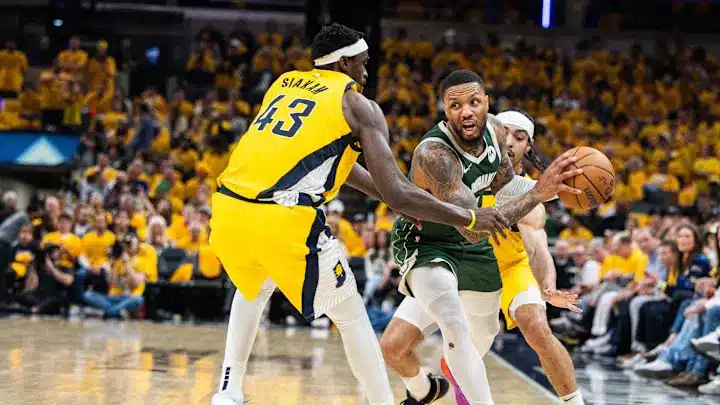The pick-and-roll revolution has entered a new stage, one in which several teams are making defensive improvements against ball-screens that can prove decisive in games.
High-Gravity Matchups
During last week’s double-round, FC Barcelona re-ran its schedule from the 2021 Turkish Airlines EuroLeague Final Four in Cologne, hosting AX Armani Exchange Milan in Round 20 and then Anadolu Efes Istanbul in Round 21. Falling 75-73 to Milan, its pick-and-roll attack was held in check, but Barcelona bounced back for an 82-77 win over the reigning champions.
Checking in on the pick-and-roll revolution
While pick-and-roll play was key to last week’s top matchups, its rise as the cornerstone of EuroLeague offenses plateaued five years ago and its calculus has gotten complicated this season.
Since the 2016-17 season, 40% of all half-court possessions in the EuroLeague have been created out of pick-and-rolls, meaning they were used by either the ball-handler, the roll man, or a player receiving the ball who wound up open because of how the defense reacted to the initial ball-screen action. That 2016-17 season still represents a pivot-point for both ball-screen frequency and efficiency. It is both the moment when the volume of ball screen-derived offense had doubled from the previous decade and the first of two major jumps in points per possession. Possessions created out of pick-and-rolls were worth around 0.92 points per possession prior to the 2016-17 season but jumped to 0.96 that year. Efficiency spiked during the record-breaking 2017-18 campaign as possessions used or created out of ball screens were converted for a staggering 1.00 points per possession before frequency crested the following year at around 43%.
There has been a readjustment period in recent seasons as there has been quite a bit of push and pull with coaches fine tuning the way that they approach pick-and-roll play on both ends of the floor. The early adjustments starting half a decade ago when defenses began prioritizing the different ways in which they could cover the ball before turning their attention more heavily to what they were doing away from the ball, which lead to a rise in ball handler usage. Subsequently, switching on pick-and-rolls became a luxury for defenses that could make it work, and that made it more difficult for offenses to rely on ball screens, which in turn lessened the burden of preparing multiple complex defensive coverage schemes. However, even after several seasons of these chess matches playing out on the floor, defenses continued to come up with the short straw, allowing 0.99 points per possession created out of ball screens last season.
The pendulum has swung the other way this season as the value of those possessions generated via pick-and-roll has fallen to 0.94 points per possession. Several teams seem to have solved the Rubik’s Cube dilemma of stopping such plays. The dance of defending ball screens is complicated at every level of basketball, but that has been particularly true in the EuroLeague in recent years. The degree of communication and attention to detail required of all five players on the floor to stifle a quality pick-and-roll attack is remarkably high, and even when teams get everything right, the spacing and shooting of modern offenses may ultimately win the day.
Just dealing with the two pick-and-roll protagonists – the ball-handler and the roll man – has always presented a challenge. But being in position to take away the skip pass or the extra pass to the corner requires a constant scramble on the part of the defenders. That’s what makes what several teams have accomplished defensively this season so impressive. Only a handful of teams since the EuroLeague moved to its current format during the 2016-17 season have held opposing teams to under 0.90 points per possession created out of pick-and-rolls. This season, five teams are on pace to accomplish that feat. Since the efficiency rates of ball-handlers and screeners have been steady in recent years, much of the success of the five teams above can be traced to the way they have defended the shots created by passes out of the pick-and-roll.
All this tracks back to Barcelona’s performance in the double-round. As one of the only teams to make a major jump in offensive pick-and-roll efficiency from last season to this, Barcelona scored 23 points out of ball screens against Milan and 36 against Efes. Milan may not rank among the top pick-and-roll defenses this season and got burnt by a couple pass-out threes on Tuesday, but its defenders’ preparation was apparent as they minimized risk by sticking to the coverage principles as well as they have all season. Considering how competitive EuroLeague games tend to be, it’s the little things that can move the dial, and ball-screen defense is a chip teams have been able to play meaningfully this season for the first time in almost a decade.
Looking Ahead to Round 22
At the moment, the intrigue in the standings sits at the bottom of the playoff picture, but the prospect of a UNICS Kazan and Barcelona rematch is the clear headliner. UNICS nearly knocked Barcelona off in Palau Blaugrana in Round 17 in one of the most exciting games in recent memory but has not played since its subsequent victory over Efes on December 30th. UNICS is among several teams emerging from stoppages due to game suspensions, so it will be interesting to see which of them hits the ground running.






